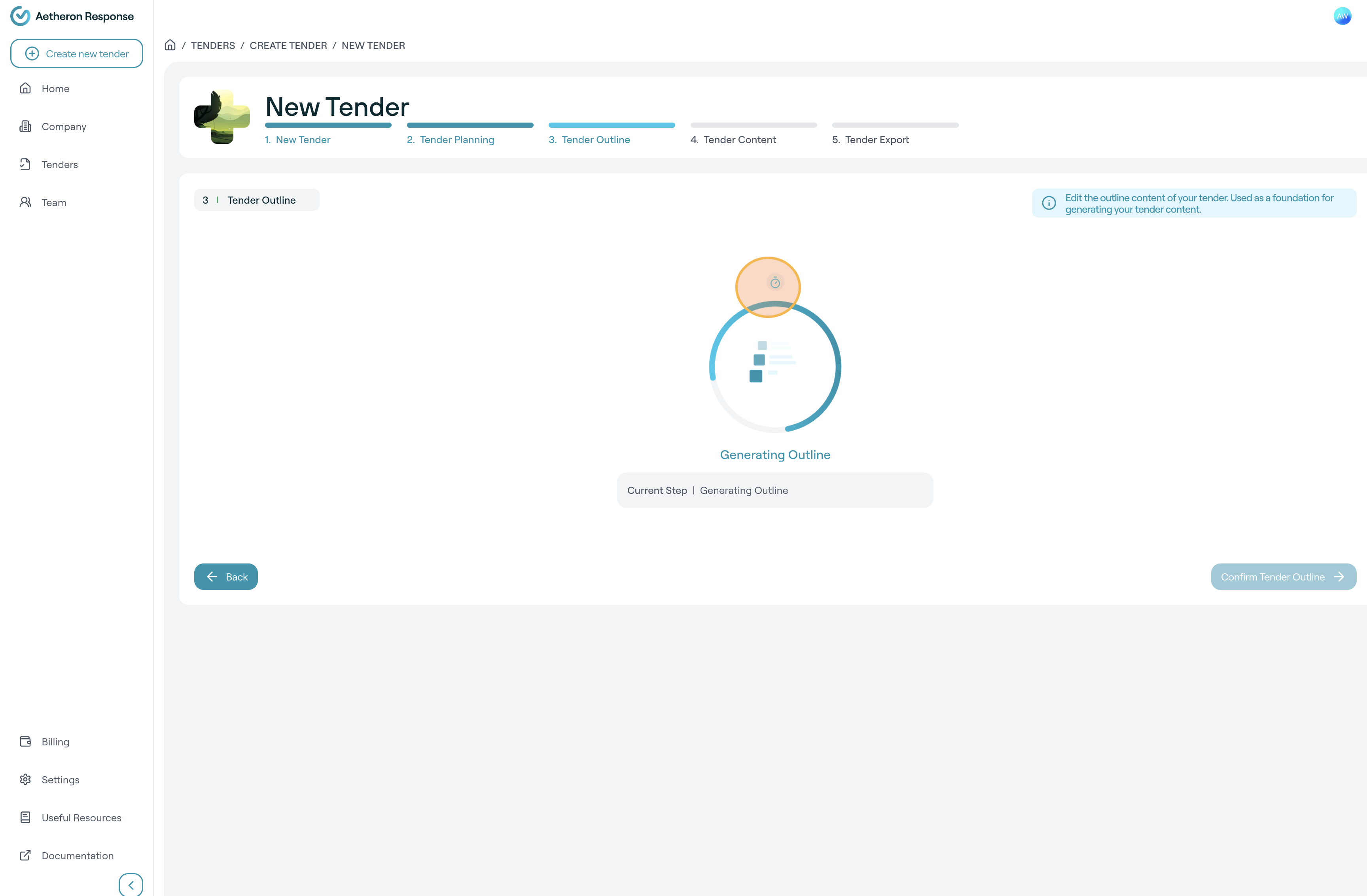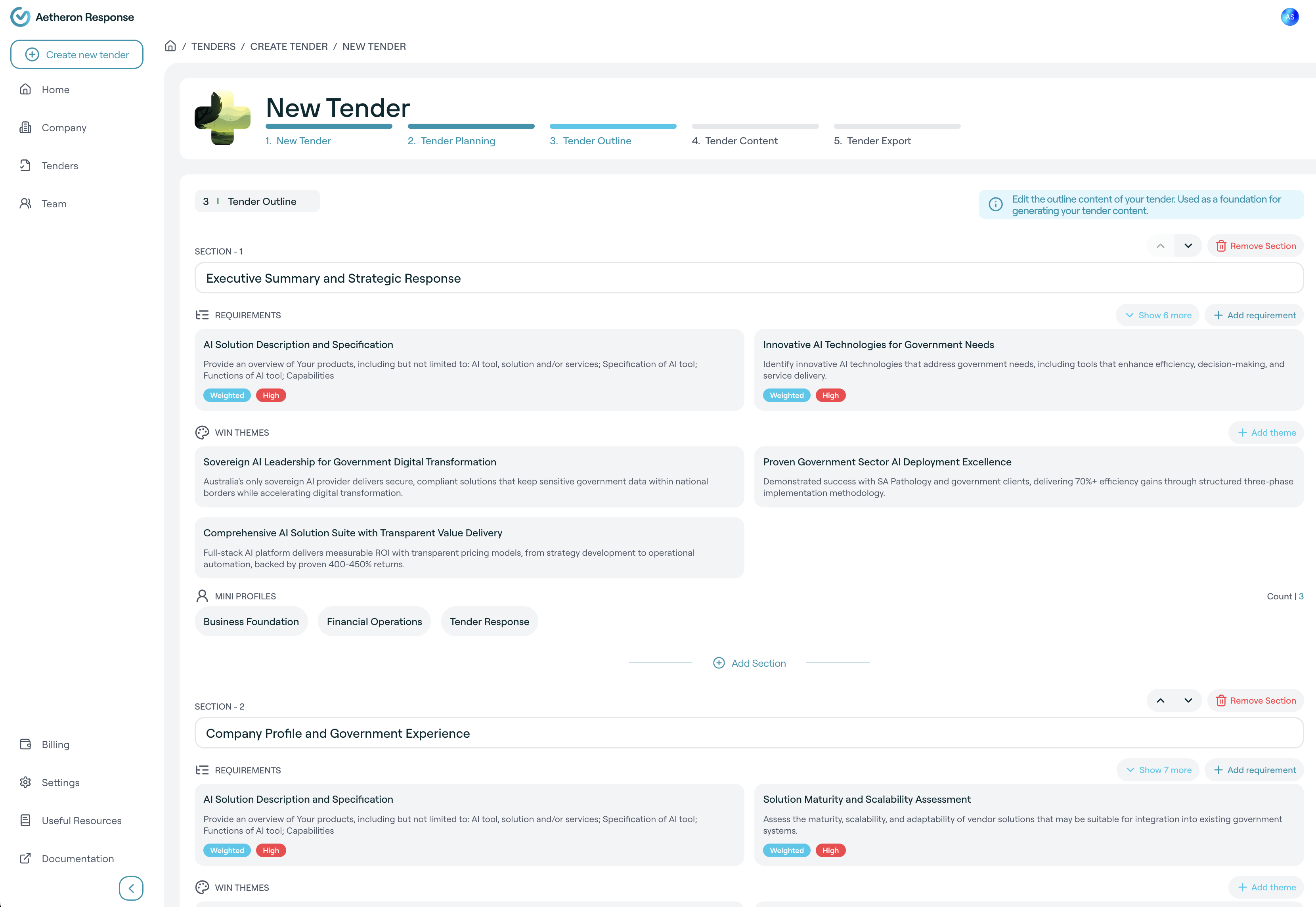Tender Outline Phase
The Tender Outline phase creates the structure and framework for your tender response. TenderCreator.ai generates a comprehensive outline that organises all requirements into logical sections and ensures complete coverage of the RFT requirements.
Overview of Tender Outline
Purpose of Outline Phase
The outline phase serves several critical functions:
- Organises requirements: Groups related requirements into logical sections
- Ensures completeness: Verifies all RFT requirements are addressed
- Creates structure: Provides framework for content generation
- Strategic alignment: Incorporates win themes into document structure
What Gets Generated
During outline generation, the AI creates:
- Section structure: Logical organisation of content areas
- Requirement mapping: Assignment of requirements to appropriate sections
- Win theme integration: Strategic themes woven throughout sections
- Mini profiles: Company capabilities mapped to relevant sections
Outline Generation Process
Starting Outline Generation
After completing the planning phase:
- Navigate to Tender Outline from the planning page
- Click "Generate Outline" or proceed automatically from planning
- AI processing begins to analyse requirements and create structure
- Monitor progress through visual indicators
Generation Progress Tracking

During outline creation, you'll see:
- Progress indicator: Circular progress showing completion percentage
- Current step: "Generating Outline" status message
- Processing status: Real-time updates on generation progress
- Estimated time: Approximate completion timeline
The AI performs several analyses during generation:
- Requirement grouping: Organises requirements by logical themes
- Section creation: Develops appropriate section headings
- Content mapping: Assigns requirements and win themes to sections
- Structure optimisation: Ensures logical flow and completeness
Generated Outline Structure
Typical Outline Sections
A generated outline commonly includes:
Section 1: Executive Summary and Strategic Alignment
- Purpose: High-level overview and strategic positioning
- Requirements covered: Contract value, duration, strategic objectives
- Win themes integrated: Primary strategic themes and value propositions
- Mini profiles: Business Foundation, Brand & Community Impact
Section 2: Understanding Your Requirements
- Purpose: Demonstrate comprehension of client needs
- Requirements covered: Mandatory compliance requirements
- Content focus: Requirements analysis and compliance approach
- Mini profiles: Solutions Technology, Client Experience & Success
Section 3: Technical Solution Architecture
- Purpose: Detailed technical approach and methodology
- Requirements covered: Technical specifications and implementation
- Content focus: Architecture, technology stack, implementation plan
- Mini profiles: Solutions Technology, Innovation & Sustainability

Section Details and Organisation
Each section in the outline shows:
- Section title: Clear, descriptive heading
- Requirement count: Number of requirements addressed in this section
- Win themes: Strategic themes incorporated into the section
- Mini profiles: Company profile sections relevant to this area
The outline ensures complete coverage with no duplication, logical grouping of related requirements, and strategic alignment supporting win themes.
Reviewing and Customising the Outline
Outline Review Interface
The generated outline provides viewing and editing options:
Section Management
For each section, you can:
- View requirements: See which requirements are addressed
- Review win themes: Check strategic theme integration
- See mini profiles: Understand which company capabilities are featured
- Edit section details: Modify section titles and organisation
Navigation Options
The interface includes:
- Sections view: Overview of all sections and their content
- List view: Detailed view of requirements and assignments
- Toggle options: Switch between different viewing modes
- Add sections: Create additional custom sections if needed
Customisation Options
Adding New Sections
If you need additional sections:
- Click "Add Section" button
- Enter section title and description
- Assign requirements to the new section
- Select relevant mini profiles for content
- Position section in appropriate location
Modifying Existing Sections
To customise sections:
- Edit section titles: Update headings for better clarity
- Reassign requirements: Move requirements between sections
- Adjust win themes: Modify strategic theme integration
- Update mini profiles: Change which company capabilities to highlight
Section Content Preview
For each section, you can preview:
- Requirements list: All requirements assigned to this section
- Win themes: Strategic themes that will be integrated
- Mini profiles: Company profile content to be included
- Content outline: High-level structure of section content
Understanding Section Requirements
Requirement Assignment Logic
The AI assigns requirements to sections based on:
- Content relevance: Requirements are placed where they logically belong
- Strategic importance: High-priority requirements get prominent placement
- Compliance type: Mandatory requirements are clearly addressed
- Win theme alignment: Requirements support strategic positioning
Requirement Details in Sections
For each requirement within a section, you can see:
- Requirement ID: Reference number from original analysis
- Priority level: High, Medium, or Low priority indication
- Compliance type: Mandatory, Weighted, or Informational
- Description: Full requirement details and expectations
You can modify requirement placement by moving between sections, creating new groupings, adding custom requirements, or marking completion status.
Win Theme Integration
Strategic Theme Placement
Win themes are strategically integrated throughout the outline:
- Executive summary: Primary themes featured prominently
- Technical sections: Themes that demonstrate technical superiority
- Experience sections: Themes showcasing successful delivery
- Compliance sections: Themes addressing risk mitigation
The AI ensures relevant placement where themes add most value, consistent messaging reinforced across sections, evidence support backing themes with company capabilities, and competitive differentiation highlighting unique advantages.
Customising Theme Integration
You can adjust how themes are integrated:
- Emphasise themes: Increase focus on specific strategic themes
- Redistribute themes: Move themes to different sections
- Add theme variations: Include different aspects of core themes
- Remove themes: Exclude themes that don't fit the section
Mini Profile Integration
Company Profile Sections
Mini profiles provide company-specific content for tender sections:
- Business Foundation: Core company information and capabilities
- Solutions Technology: Technical expertise and innovation
- Client Experience & Success: Project history and customer satisfaction
- Innovation & Sustainability: R&D and environmental capabilities
- Financial Operations: Performance and stability indicators
Profile-Section Mapping
The outline shows which mini profiles will contribute to each section, including relevant experience with appropriate case studies, capability demonstration of technical and service capabilities, credibility building through certifications, and risk mitigation via financial stability.
You can control how profiles are used by adding additional company profile sections, removing less relevant content, prioritising most important strengths, or customising how profile content should be integrated.
Finalising the Outline
Quality Review Checklist
Before proceeding to content generation:
Completeness Check
- ✅ All requirements addressed: Every RFT requirement is assigned to a section
- ✅ Logical organisation: Sections flow logically and support each other
- ✅ Strategic alignment: Win themes are appropriately integrated
- ✅ Company positioning: Mini profiles support competitive positioning
Structure Validation
- ✅ Clear section titles: Headings are descriptive and professional
- ✅ Appropriate length: Sections are sized appropriately for content
- ✅ No gaps or overlaps: All content areas are covered without duplication
- ✅ Compliance focus: Mandatory requirements are prominently addressed
Confirming the Outline
When you're satisfied with the outline:
- Review all sections for completeness and logic
- Check requirement coverage to ensure nothing is missed
- Verify strategic alignment with your win themes
- Confirm company positioning through mini profile integration
- Click "Confirm Outline" to proceed to content generation
After confirming, content generation begins with AI creating detailed content for each section, progress tracking to monitor creation, section-by-section systematic creation, and quality optimisation ensuring professional standards.
Best Practices for Outline Phase
Structure Optimisation
- Logical flow: Ensure sections build upon each other logically
- Strategic emphasis: Place most important content prominently
- Reader experience: Consider how evaluators will read and score
- Compliance clarity: Make mandatory requirements easy to find
Strategic Alignment
- Win theme consistency: Ensure themes are reinforced throughout
- Competitive positioning: Structure supports your unique advantages
- Client focus: Organise content around client needs and priorities
- Evidence placement: Position supporting evidence strategically
Requirement Management
- Complete coverage: Verify all requirements are addressed
- Appropriate placement: Put requirements where they fit best
- Priority emphasis: Give high-priority requirements prominent placement
- Clear mapping: Ensure requirements are easy to locate and evaluate
Troubleshooting Outline Issues
Common Problems and Solutions
Missing Requirements
If requirements seem missing:
- Check all sections (requirements may be in unexpected sections)
- Review original analysis to verify correct extraction
- Add missing requirements manually to appropriate sections
- Contact support for help with complex requirement mapping
Poor Section Organisation
If the structure doesn't make sense:
- Reorganise sections into more logical groupings
- Rename sections with clearer, more descriptive titles
- Merge sections that are too small or similar
- Split sections that are too large or complex
Win Theme Misalignment
If themes don't fit well:
- Review theme relevance to ensure alignment with capabilities
- Redistribute themes to more appropriate sections
- Modify theme content to better fit sections
- Remove themes that don't add value
Updated 18 days ago
